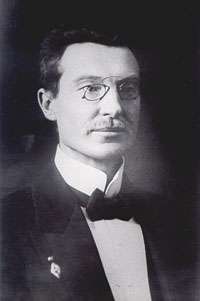Ado Birk
| Ado Birk | |
|---|---|
 | |
| 3rd Prime Minister of Estonia | |
|
In office 28 July 1920 – 30 July 1920 | |
| Preceded by | Jaan Tõnisson |
| Succeeded by | Jaan Tõnisson |
| Personal details | |
| Born |
14 November 1883 Mõnnaste, Tarvastu Parish, Estonia (then Kreis Fellin, Governorate of Livonia, part of the Russian Empire) |
| Died |
2 February 1942 (aged 58) Sosva, Sverdlovsk Oblast, Russian SFSR |
| Nationality | Estonian |
| Political party |
People's Party National Centre Party later none |
| Alma mater |
Saint Petersburg Theological Academy University of Tartu Saint Petersburg State University University of Leipzig |
| Profession | lawyer |
| Religion | Eastern Orthodox Church |
Ado Birk (also known as Aadu Birk, Aado Birk or Avdei Birk; 14 November [O.S. 2 November] 1883 – 2 February 1942), was an Estonian politician who was the Estonian Prime Minister for three days, from 28 July 1920 to 30 July 1920.
Biography
Ado Birk was born in Kulbisaare farmstead, Mõnnaste village, Tarvastu Parish, Kreis Fellin, Governorate of Livonia. He graduated from the Theological (Orthodox) Seminary in Riga, studied in the Saint Petersburg Theological Academy, and in the law departments of the Tartu (1907–1908), Saint Petersburg (1908–1911) and Leipzig (1911) universities.
Between 1911–1912 he was Head of the Tallinn Statistical Bureau. From 1912–1917 he worked as a solicitor to barrister Jaan Poska.
In 1917 he was made provisional secretary of the Estonian Province Assembly (Eesti Maanõukogu), and in 1918 was made representative of Estonia in Helsinki, Finland. From 1918 to 1919 he was Chairman of Estonian Province Assembly and chairman of General Committee of Elections to the Constituent Assembly (Asutav Kogu). From 1919 to 1920 he was vice chairman of Constituent Assembly and Minister of Foreign Affairs, again in 1920 and in 1925. He was prime minister for three days from 28 July 1920 to 30 July 1920. Between 1917–1924, Birk was also chairman of the Tallinn Voluntary Society of Firemen, in 1919–1922 chairman of the All-Estonian Union of Firemen.
From 1922 to 1926 he was Envoy of Estonia in the Soviet Union. As an Envoy to the Soviet Union, he had in the beginning of 1926 a conflict with the Estonian Ministry of Foreign Affairs, and refused to return after his demotion. In summer of 1926, he fell victim to the provocation of the Soviet secret service GPU, and was imprisoned in Russia, but was soon released and returned to Estonia in 1927. He was accused of forwarding secret information to the USSR and was in pretrial imprisonment, in November 1927 was acquitted by the Tallinn-Haapsalu Peace Council (Estonian: Rahukogu).
In the second half of 1920s and in the 1930s, he became active in the Estonian Apostolic Orthodox Church (EAOC), and in 1939–1940 was the Ecumenical Secretary of the EAOC whilst serving as a businessman in Tallinn.
With the onset of the Second World War, he was arrested by the NKVD (People's Commissariat of Internal Affairs, (the Soviet secret police) and on 14 June 1941, was in the Sosva prison camp, and was sentenced to death but died before the execution at Sosva, Sverdlovsk oblast, Russia (see Gulag).
References
| Political offices | ||
|---|---|---|
| Preceded by Jaan Tõnisson |
Prime Minister of Estonia 28 July 1920 – 30 July 1920 |
Succeeded by Jaan Tõnisson |
| Preceded by Ants Piip |
Minister of Foreign Affairs 1919–1920 |
Succeeded by Kaarel Robert Pusta |
| Diplomatic posts | ||
| Preceded by Tõnis Vares |
Envoy of Estonia to Soviet Union 1922–1926 |
Succeeded by Heinrich Laretei |
